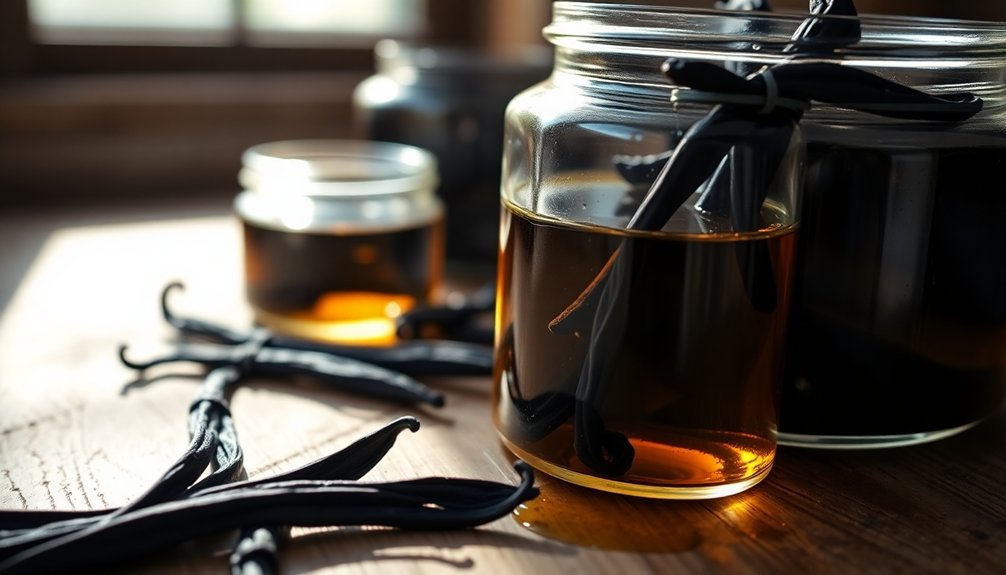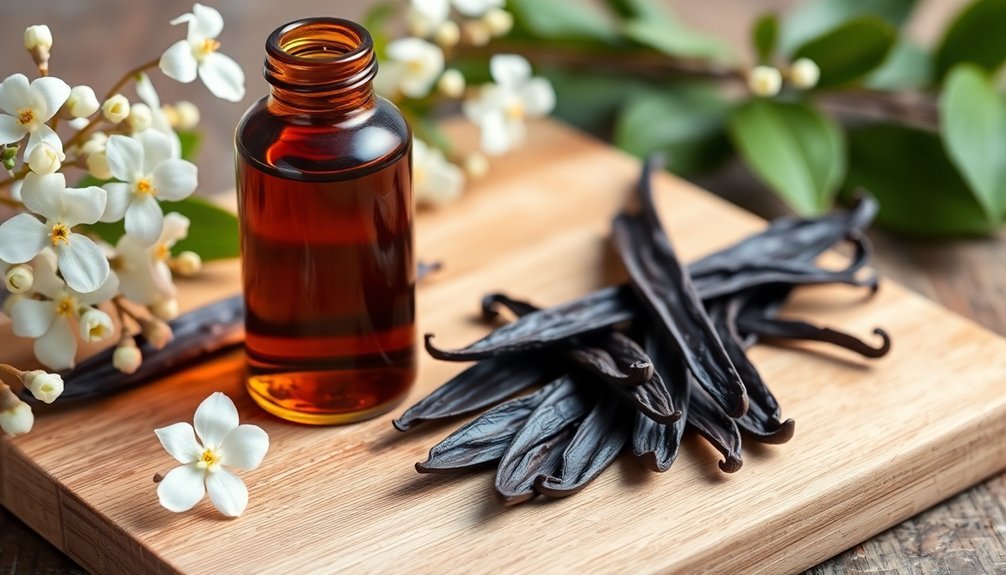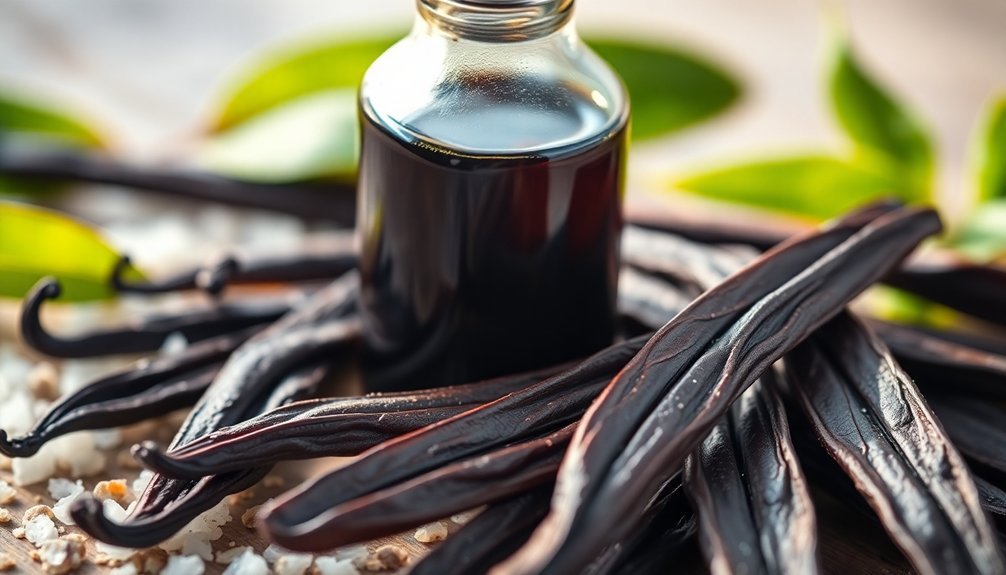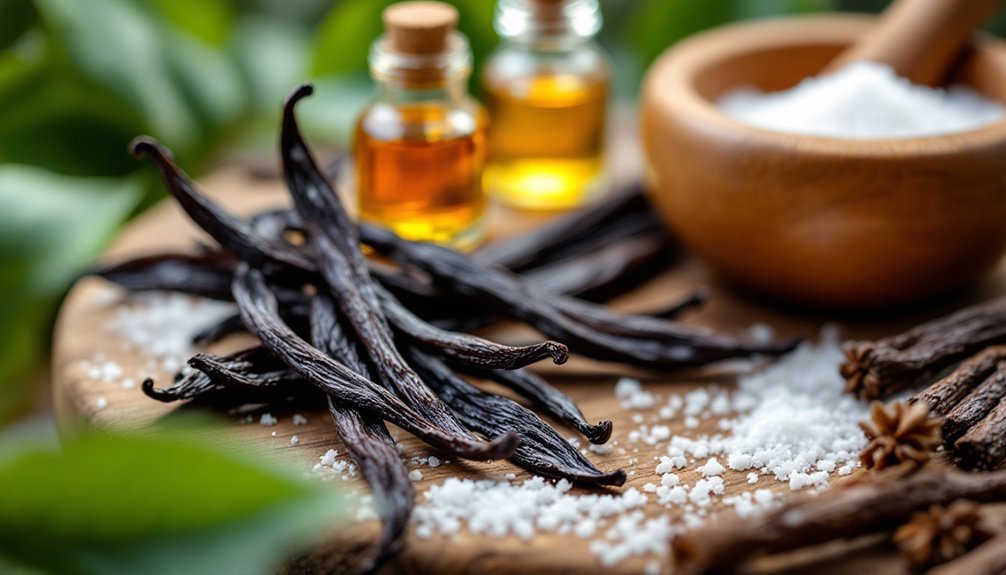Five proven methods let you create pure vanilla fragrance at home: cold infusion with honey base, heat-accelerated extraction using ethanol, absolute oil preparation through solvent extraction, alcohol-based maceration, and double-extraction concentration. Each technique offers unique benefits – from preserving delicate compounds to producing intense aromas. Whether you're a perfume enthusiast or DIY creator, these methods range from simple two-ingredient processes to advanced extraction techniques that'll transform your fragrance journey.
The Cold-Infusion Vanilla Bean Method

Three key ingredients form the foundation of the cold-infusion vanilla bean method: high-quality vanilla beans, mild honey or a neutral base, and a suitable solvent.
You'll need moist, plump beans that show an oily residue for the best results.
Start by slicing your vanilla beans lengthwise and scraping out the seeds. Combine these with your chosen base in a clean glass container.
Let the mixture steep for 5-7 days at room temperature, making sure to stir or flip the container regularly to keep the vanilla submerged. You can create this infusion with just two ingredients for a simple yet effective recipe.
This method's simple but effective approach yields complex flavor profiles perfect for culinary uses.
You'll create a versatile ingredient that enhances baked goods and desserts while being cost-effective.
Remember to store your infusion in a clean, dry environment with minimal light exposure.
Heat-Accelerated Vanilla Extract Process
While cold infusion offers a gentle approach, the heat-accelerated vanilla extract process provides a faster route to achieving rich vanilla flavors.
You'll need a mixture of ethanol and water (35-50% ethanol concentration) and precise temperature control around 146°F for ideal results.
Using immersion circulation techniques, you can maintain consistent heat while extracting vanillin and other flavor compounds from your beans. This method considerably reduces the traditional waiting period from months to just days or weeks.
However, you'll need to carefully monitor the temperature, as excessive heat can denature valuable compounds and diminish subtle aromatic notes.
For best results, focus on using fewer high-quality beans rather than more lower-grade ones. Soxhlet extraction methods typically require operating temperatures of 95°C for optimal yield.
Consider using vacuum conditions if possible, as this helps preserve delicate flavors while maintaining extraction efficiency.
Vanilla Absolute Oil Preparation

Creating vanilla absolute oil demands a sophisticated two-step solvent extraction process that yields one of the most concentrated vanilla fragrances available.
You'll need to use both non-polar and polar solvents, typically benzene followed by ethanol, to extract the aromatic compounds from vanilla beans.
This method produces a highly potent fragrance that's prized in high-end perfumery for its soft, rich aroma profile.
While it's more expensive than vanilla oleoresin or CO₂ extracts, the absolute's concentrated nature makes it ideal as a base note and smoothing agent in perfume blends.
You'll need to handle it carefully, as it's sensitive to heat and harsh conditions.
Due to its cost and limited availability, you'll often find synthetic vanillin used as a substitute in mass-market products.
The process begins with dried, fermented pods that have been carefully cured over several months to develop their characteristic vanilla flavor and aroma.
Alcohol-Based Vanilla Maceration
To produce a rich vanilla extract at home, you'll need to master the art of alcohol-based maceration – a process that harnesses alcohol's natural solvent properties to draw out vanilla's complex flavor compounds.
Start by selecting high-quality vanilla beans and splitting them lengthwise. Place 8-12 beans in a mason jar with 16 ounces of your chosen alcohol – vodka offers a neutral base, while rum adds unique notes.
Store your mixture in a cool, dark place for at least two months, gently shaking it occasionally to aid extraction.
You'll find that cold maceration yields fruity, floral notes, while avoiding high temperatures preserves delicate compounds.
Don't rush the process with pressure cookers or sous vide methods, as they can damage the flavor molecules. When properly stored, your extract will remain flavorful for over a year.
Double-Extraction Vanilla Concentrate

Building upon the principles of basic maceration, double-extraction vanilla concentrate offers a more potent alternative for those seeking maximum flavor impact.
You'll need to start with high-quality vanilla beans that have been properly cured and conditioned to develop their flavor compounds.
The process involves using twice the amount of vanilla beans compared to single-fold extract, often combined with techniques like vacuum distillation or freeze concentration.
You'll achieve a more concentrated product that's twice as strong as regular vanilla extract. The higher alcohol content helps preserve the intense flavor while extending shelf life.
When you're using double-fold extract in recipes, remember to adjust your measurements accordingly – you'll need only half the amount compared to regular extract to achieve the same flavor intensity.
Frequently Asked Questions
Can I Use Vanilla Beans That Have Been Previously Used in Cooking?
Yes, you can reuse vanilla beans after cooking! You'll get multiple uses from them, whether making extract, vanilla sugar, or infusing desserts. Just make certain they're properly cleaned and stored between uses.
Why Does My Homemade Vanilla Fragrance Smell Different From Commercial Perfumes?
Your homemade vanilla fragrance differs because commercial perfumes use synthetic vanillin and complex layering techniques, while you're likely using natural vanilla, which has a simpler, more subtle scent profile.
How Do I Prevent Vanilla Fragrance From Staining My Clothes?
To prevent stains, spray vanilla fragrance on your skin, not clothes. Let it dry completely before dressing, use fabric-safe formulas, and target pulse points. Don't apply directly to light or delicate fabrics.
What Causes Vanilla Fragrance to Turn Darker Over Time?
Your vanilla fragrance darkens because vanillin oxidizes when exposed to air, light, and heat. The higher the vanillin concentration in your fragrance, the more noticeable this natural browning process becomes.
Can Pregnant Women Safely Use Pure Vanilla Fragrances?
You can generally use pure vanilla fragrances during pregnancy, but it's best to choose phthalate-free options. Your sensitivity may increase, so start with small amounts and discontinue if discomfort occurs.





Leave a Reply